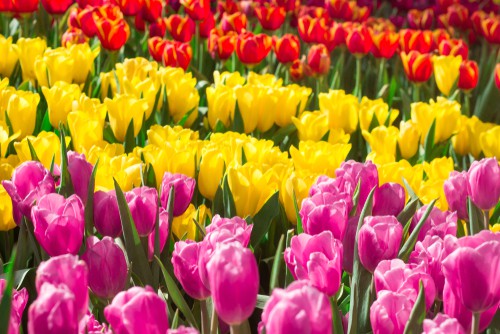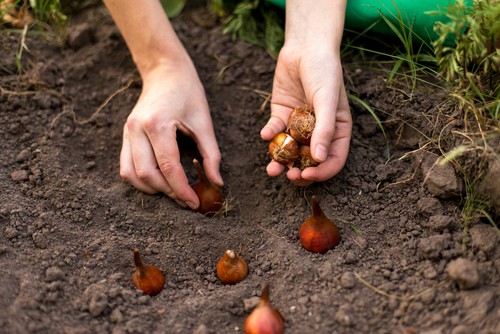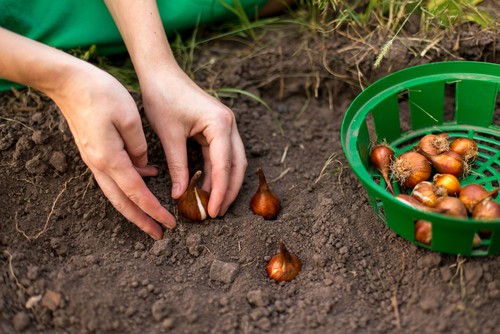Last updated on March 15th, 2022
Our site is reader supported, this means we may earn a small commission from Amazon and other affiliates when you buy through links on our site.
Tulips are one of the most popular bulbs and if you plant them in autumn you will have a wonderful spring display waiting for you. The best part is, there is a large range of variety options out there so you can mix and match or stick with a specific colour theme.
There are actually 15 divisions of tulips based on the characteristics of the flowers. In broad terms, you can find tulips flowers that are cup-shaped, goblet-shaped, star-shaped, fringed, and much more. When you are choosing the Tulips for your garden you should consider not just the flower type but the flowering times, and whether the variety you select is suitable for borders or containers. There are certain Tulips that are best for fine grass and others that are best for containers or borders while some really need to be replaced every year. This variety is usually the bedding tulips, so this is something to consider.

In terms of colour, you can pick from white flowers, pink flowers, purple-black or violet-blue flowers, yellow, apricot, red, or crimson. There are of course rare and unusual collections that embody a handful of colours too. Simply put, the variety of Tulips available is truly enormous.
When to Plant Tulips
Plant in the middle to the end of autumn

Tulips should be planted from the middle of autumn until the end of autumn. The more experienced of you will notice this is later than most bulbs should be planted, however, the late planting is beneficial for new bulbs in particular because it reduces the risk of diseases like tulip fire and has no real negative effects.
Where to Plant Tulips
Tulips are great for informal or formal borders and garden beds. There are annual or biennial plants available. They also make useful plants when grown in containers for some spring colour. If you wish to have them naturalised in grass such as under the lawn, there are some varieties that serve this purpose well.

Only plant healthy firm bulbs
Species tulips usually reflower while bedding ones don’t
When you are planting new bulbs you should only use those that are healthy and toss out any that have signs of damage or mould. Most of the bedding type tulips need to be replaced every year and if you leave them in the ground they will likely not re-flower. Species tulips, however, will re-flower without lifting so most of the time if you have a species tulips you will need to leave them in the ground only lifting to divide them when they get overcrowded so these are are our tulips of choice.
Try not to waste bedding tulips after they’ve finished flowering
If you don’t want to discard your old bulbs you can always lift and dry the existing tulip bulbs after they have flowered. You can deadhead after the flowers have bloomed to prevent seed production and then wait for the foliage to turn yellow. Usually, this should take about six weeks after flowering has been completed. Then you can lift the bulbs, clean them off, discard any that are damaged or diseased, and allow them to sit overnight to dry.
Once they are dry you can store them in trays or net bags in a dark, warm, well-ventilated place that remains between 18 degrees C and 20 degrees C. You can then replant them in the autumn. If you are not 100% certain about the reflowering of your old bulbs you can always use them in less important areas of the garden and reserve the showcase regions of your garden for new bulbs and species bulbs. This will help avoid disappointment if they don’t flower as expected. Remember those species varieties can be left in the ground if the area is well-drained.
The Best Soil for Bulbs
Tulips grow best in well-drained fertile soil with exposure to full sunlight and protection against the strong wind. They do not like excessively wet conditions or windy conditions as the large flower heads don’t fair well.

If you suffer from back problems or want to make planting bulbs easier, don’t forget to check out our review of the best long-handled bulb planters.
Soil type
If you have clay or sandy soil you can improve it for tulip bulbs by adding organic matter. You can improve clay soil additionally with coarse gravel. If you have nutrient-poor soil you can add chicken manure pellets to the area before you plant. Tulips prefer neutral to alkaline soils and if you have a pH that is lower than 6.5 you might want to consider adding some lime to your soil to make it more suitable for tulips.
How to Plant Tulips
Tulips are quite easy to plant. Once you have selected the area where you want them to grow, whether it is in the ground, in a grassy field, or in a container, and you have added the proper soil mixture, you simply dig a hole, or a trench if you are growing them in a border, and place them at the appropriate depth, which again is contingent upon the size of the bulb. As a guide, 3 times the depth of the bulb is about right, and then cover them. You never want to step on the area where they are planted to pat down the soil as this could damage the crown, ideally just lightly rake the area over. Instead, pat it down gently with your hand or water it removing the air pockets.
Planting tulips under grass
If growing in a naturalised grass area, it is recommended that you throw the Tulips casually across the field and then dig holes where they land. This gives a scattered, wildflower approach to the final product. If you are growing them in borders or you want them to be formal lines or patterns, it can be easier to simply use a spade to dig up large sections of the trench, place the bulbs underneath, and then put the soil and grass back on top.
Planting depths for bulbs

They should be planted at least twice the width of the bulb apart from one another and a depth that is about two or three times the height of the bulb. Because the size of the bulbs varies it’s better to use the bulb itself as your measurement.
Propagation
Propagating by division
You can propagate your tulips with one of two methods. The first is through division which is is probably the best and quickest way to get new bulbs to plant. You can separate any offsets when you lift your bulbs to store them and then replant the offsets approximately 20cm deep. Propagation is a long-term strategy for obtaining more tulips because you will not get flowers the first season after you plant the offsets.
Propagating from seed (not advised for the impatient)
The second is through seed. You can wait until the seeds appear and then sow them in autumn. You need to give the seeds enough time to germinate evenly something that requires a period of frost. If you are growing from seed you will not likely get flowers for at least four years. Some varieties take up to seven years so we don’t really recommend growing them by seed.
Overall, tulips come in many shapes and sizes so you have no limits when it comes to how you want your pots or garden area to be decorated. Whether you want to plant rows of monochromatic floral designs or you want flowerbeds that spring forth like a rainbow, there’s something for everyone.


